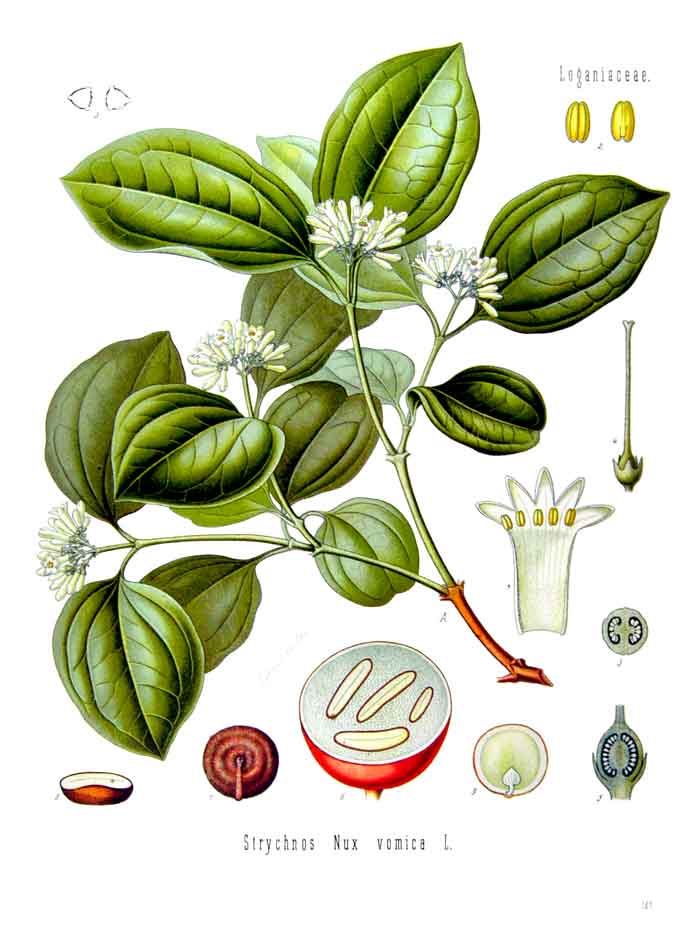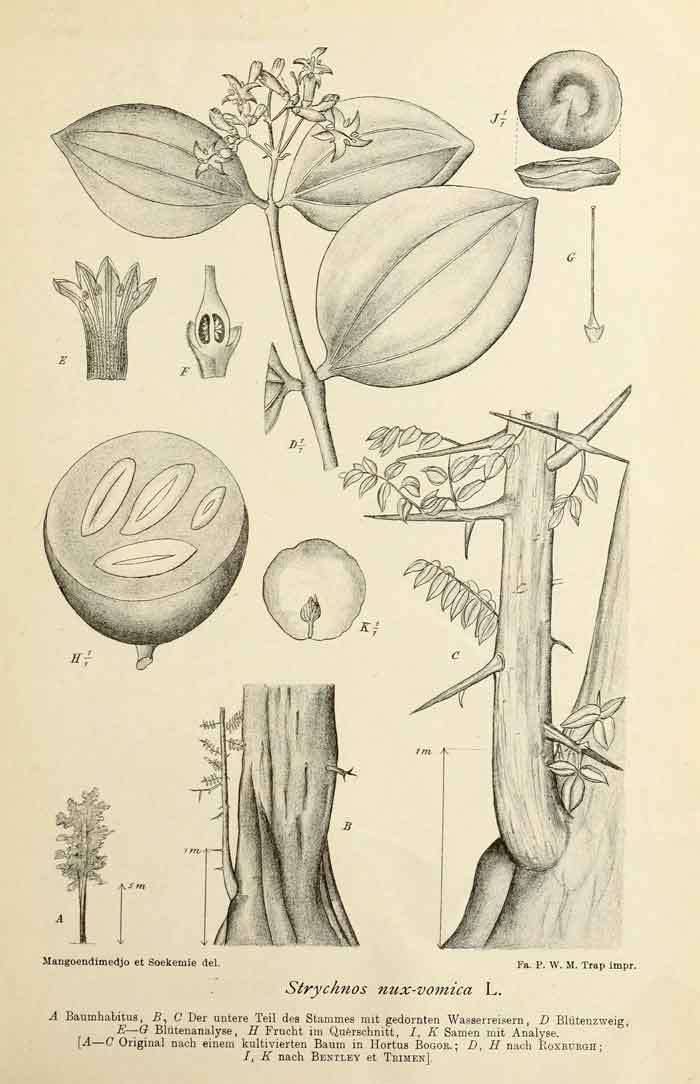
Classification System: APG IV
Superregnum: Eukaryota
Regnum: Plantae
Cladus: Angiosperms
Cladus: Eudicots
Cladus: Core eudicots
Cladus: Asterids
Cladus: Lamiids
Ordo: Gentianales
Familia: Loganiaceae
Tribus: Strychneae
Genus: Strychnos
Species: Strychnos nux-vomica
Name
Strychnos nux-vomica L.

References
Linnaeus, C. 1753. Species Plantarum. Tomus I: 189. Reference page.
USDA, ARS, Germplasm Resources Information Network. Strychnos nux-vomica in the Germplasm Resources Information Network (GRIN), U.S. Department of Agriculture Agricultural Research Service. Accessed: 07-Oct-06.
Vernacular names
العربية: جوز مقيء
беларуская: Чылібуха
dansk: Rævekage
Deutsch: Gewöhnliche Brechnuss
ދިވެހިބަސް: ތަނބިވައް
English: Strychnine tree, poison nut, Quaker buttons
suomi: Strykniinipuu
magyar: Ebvész
日本語: マチン
ಕನ್ನಡ: ಕಾಸರಕ
മലയാളം: കാഞ്ഞിരം
Nederlands: braaknoot, strychnine
polski: Kulczyba wronie oko
русский: Чилибуха
svenska: Rävkaketräd
தமிழ்: எட்டி
తెలుగు: ముషిడి
ไทย: แสลงใจ
Türkçe: Kargabüken
Tiếng Việt: Mã tiền
Strychnos nux-vomica, the strychnine tree,[2] also known as nux vomica, poison fruit, semen strychnos, and quaker buttons, is a deciduous tree native to India and to southeast Asia. It is a medium-sized tree in the family Loganiaceae that grows in open habitats. Its leaves are ovate and 5–9 centimetres (2–3.5 in) in size.[3] It is known for being the natural source of the extremely poisonous compound strychnine.
Description and properties
This section needs additional citations for verification. Please help improve this article by adding citations to reliable sources. Unsourced material may be challenged and removed. (October 2015) (Learn how and when to remove this template message)
Seeds of S. nux-vomica
Strychnos nux-vomica is a medium-sized tree with a short, thick trunk. The wood is dense, hard white, and close-grained. The branches are irregular and are covered with a smooth ashen bark. The young shoots are a deep green colour with a shiny coat. The leaves have an opposite decussate arrangement (each opposing pair of leaves at right angles to the next pair along the stem), are short stalked and oval shaped, have a shiny coat, and are smooth on both sides. The leaves are about 10 centimetres (4 inches) long and 7.6 cm (3 in) wide. The flowers are small with a pale green colour and a funnel shape. They bloom in the cold season and have a foul smell. The fruit are about the size of a large apple with a smooth and hard shell that when ripened is a mild shade of orange in colour. The flesh of the fruit is soft and white with a jelly-like pulp containing five seeds covered with a soft, woolly substance.
The seeds have the shape of a flattened disk completely covered with hairs radiating from the center of the sides. This gives the seeds a very characteristic sheen. The seeds are very hard, with a dark gray horny endosperm where the small embryo is housed that gives off no odor but possesses a very bitter taste.
Seedling of nux vomica
Ecology
The toxic fruit is eaten by monkeys and birds, such as the gray langur.[4] It is also commonly eaten by hornbill species.
Toxicity
It is a major source of the highly poisonous, intensely bitter alkaloids strychnine and brucine derived from the seeds inside the tree's round, green to orange fruit.[5] The seeds contain approximately 1.5% strychnine, and the dried blossoms contain 1.0%.[3] However, the tree's bark also contains brucine and other poisonous compounds.
Uses
The strychnine-containing seeds have been used in arrow poison.[4] The use of strychnine is highly regulated in many countries, and it is mostly used in baits to kill feral mammals. Most accidental poisoning is caused by breathing in the powder or by absorption through the skin.[6]
Strychnos is promoted within alternative medicine as a treatment for many conditions, but the claims are not supported by medical evidence.[7]
Herbalism
Bark of Strychnos nux-vomica
Strychnos is promoted within herbal medicine as being a treatment for a wide range of maladies, including cancer and heart disease.[7] There is, however, no evidence it is useful for treating any condition.[7] Indeed, these seeds contain strychnine. The plant appears on the Commission E list of unapproved herbs because it has not been proven to be safe or effective and thus is not recommended for use. Use of strychnine seeds for such purposes may prove fatal as strychnine is a highly toxic compound and has no safe limit for consumption.
In Ayurveda (the Indian system of Classical medicine), hudar is a mixture containing Strychnos nux-vomica. The seeds are first immersed in water for five days and then in milk for two days followed by their boiling in milk.[8]
The level of toxic alkaloids in the unprocessed Strychnos seeds used in traditional medicines can be determined using established HPLC methods and HPLC-UV methods.[9]
References
"Strychnos nux-vomica L." The Plant List.
USDA, NRCS (n.d.). "Strychnos nux-vomica". The PLANTS Database (plants.usda.gov). Greensboro, North Carolina: National Plant Data Team. Retrieved 4 December 2015.
Harry L. Arnold (1968). Poisonous Plants of Hawaii. Tokyo, Japan: Charles E. Tuttle. p. 20. ISBN 0-8048-0474-5.
Hargreaves, Dorothy; Hargreaves, Bob (1970). Tropical Trees of the Pacific. Kailua, Hawaii: Hargreaves. p. 59.
Oudhia, P., 2008. Strychnos nux-vomica L. [Internet] Record from PROTA4U. Schmelzer, G.H. & Gurib-Fakim, A. (Editors). PROTA (Plant Resources of Tropical Africa / Ressources végétales de l’Afrique tropicale), Wageningen, Netherlands.
"Drugs and Poisons Fact Sheet: Strychnine Permits - What you need to know" (PDF). Queensland Health. December 1, 2011. Archived from the original (PDF) on November 13, 2013.
Ades TB, ed. (2009). Strychnos nux-vomica. American Cancer Society Complete Guide to Complementary and Alternative Cancer Therapies (2nd ed.). American Cancer Society. pp. 504–507. ISBN 9780944235713.
Seema Akbar; Shamshad A Khan; Akbar Masood & M Iqbal (2010). "Use of Strychnos nux-vomica (azraqi) seeds in Unani system of medicine: role of detoxification". African Journal of Traditional, Complementary and Alternative Medicines. 7 (4): 286–290. doi:10.4314/ajtcam.v7i4.56689. PMC 3005396. PMID 21731158.
Q. B. Han; S. L. Li; C. F. Qiao; J. Z. Song; Z. W. Cai; P. Pui-Hay But; P. C. Shaw & H. X. Xu (2008). "A simple method to identify the unprocessed Strychnos seeds used in herbal medicinal products". Planta Medica. 74 (4): 458–463. doi:10.1055/s-2008-1034359. PMID 18484543.
Retrieved from "http://en.wikipedia.org/"
All text is available under the terms of the GNU Free Documentation License

